Xuerui Qiu
SpikingBrain Technical Report: Spiking Brain-inspired Large Models
Sep 05, 2025Abstract:Mainstream Transformer-based large language models face major efficiency bottlenecks: training computation scales quadratically with sequence length, and inference memory grows linearly, limiting long-context processing. Building large models on non-NVIDIA platforms also poses challenges for stable and efficient training. To address this, we introduce SpikingBrain, a family of brain-inspired models designed for efficient long-context training and inference. SpikingBrain leverages the MetaX GPU cluster and focuses on three aspects: (1) Model Architecture: linear and hybrid-linear attention architectures with adaptive spiking neurons; (2) Algorithmic Optimizations: an efficient, conversion-based training pipeline and a dedicated spike coding framework; (3) System Engineering: customized training frameworks, operator libraries, and parallelism strategies tailored to MetaX hardware. Using these techniques, we develop two models: SpikingBrain-7B, a linear LLM, and SpikingBrain-76B, a hybrid-linear MoE LLM. These models demonstrate the feasibility of large-scale LLM development on non-NVIDIA platforms. SpikingBrain achieves performance comparable to open-source Transformer baselines while using only about 150B tokens for continual pre-training. Our models significantly improve long-sequence training efficiency and deliver inference with (partially) constant memory and event-driven spiking behavior. For example, SpikingBrain-7B attains over 100x speedup in Time to First Token for 4M-token sequences. Training remains stable for weeks on hundreds of MetaX C550 GPUs, with the 7B model reaching a Model FLOPs Utilization of 23.4 percent. The proposed spiking scheme achieves 69.15 percent sparsity, enabling low-power operation. Overall, this work demonstrates the potential of brain-inspired mechanisms to drive the next generation of efficient and scalable large model design.
SVL: Spike-based Vision-language Pretraining for Efficient 3D Open-world Understanding
May 23, 2025Abstract:Spiking Neural Networks (SNNs) provide an energy-efficient way to extract 3D spatio-temporal features. However, existing SNNs still exhibit a significant performance gap compared to Artificial Neural Networks (ANNs) due to inadequate pre-training strategies. These limitations manifest as restricted generalization ability, task specificity, and a lack of multimodal understanding, particularly in challenging tasks such as multimodal question answering and zero-shot 3D classification. To overcome these challenges, we propose a Spike-based Vision-Language (SVL) pretraining framework that empowers SNNs with open-world 3D understanding while maintaining spike-driven efficiency. SVL introduces two key components: (i) Multi-scale Triple Alignment (MTA) for label-free triplet-based contrastive learning across 3D, image, and text modalities, and (ii) Re-parameterizable Vision-Language Integration (Rep-VLI) to enable lightweight inference without relying on large text encoders. Extensive experiments show that SVL achieves a top-1 accuracy of 85.4% in zero-shot 3D classification, surpassing advanced ANN models, and consistently outperforms prior SNNs on downstream tasks, including 3D classification (+6.1%), DVS action recognition (+2.1%), 3D detection (+1.1%), and 3D segmentation (+2.1%) with remarkable efficiency. Moreover, SVL enables SNNs to perform open-world 3D question answering, sometimes outperforming ANNs. To the best of our knowledge, SVL represents the first scalable, generalizable, and hardware-friendly paradigm for 3D open-world understanding, effectively bridging the gap between SNNs and ANNs in complex open-world understanding tasks. Code is available https://github.com/bollossom/SVL.
Safe-Sora: Safe Text-to-Video Generation via Graphical Watermarking
May 19, 2025

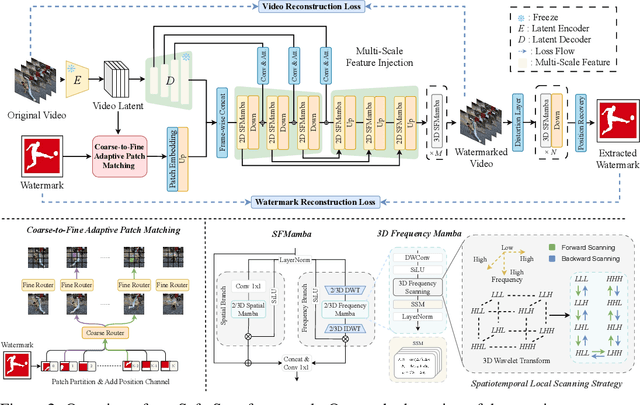

Abstract:The explosive growth of generative video models has amplified the demand for reliable copyright preservation of AI-generated content. Despite its popularity in image synthesis, invisible generative watermarking remains largely underexplored in video generation. To address this gap, we propose Safe-Sora, the first framework to embed graphical watermarks directly into the video generation process. Motivated by the observation that watermarking performance is closely tied to the visual similarity between the watermark and cover content, we introduce a hierarchical coarse-to-fine adaptive matching mechanism. Specifically, the watermark image is divided into patches, each assigned to the most visually similar video frame, and further localized to the optimal spatial region for seamless embedding. To enable spatiotemporal fusion of watermark patches across video frames, we develop a 3D wavelet transform-enhanced Mamba architecture with a novel spatiotemporal local scanning strategy, effectively modeling long-range dependencies during watermark embedding and retrieval. To the best of our knowledge, this is the first attempt to apply state space models to watermarking, opening new avenues for efficient and robust watermark protection. Extensive experiments demonstrate that Safe-Sora achieves state-of-the-art performance in terms of video quality, watermark fidelity, and robustness, which is largely attributed to our proposals. We will release our code upon publication.
Safe-VAR: Safe Visual Autoregressive Model for Text-to-Image Generative Watermarking
Mar 14, 2025Abstract:With the success of autoregressive learning in large language models, it has become a dominant approach for text-to-image generation, offering high efficiency and visual quality. However, invisible watermarking for visual autoregressive (VAR) models remains underexplored, despite its importance in misuse prevention. Existing watermarking methods, designed for diffusion models, often struggle to adapt to the sequential nature of VAR models. To bridge this gap, we propose Safe-VAR, the first watermarking framework specifically designed for autoregressive text-to-image generation. Our study reveals that the timing of watermark injection significantly impacts generation quality, and watermarks of different complexities exhibit varying optimal injection times. Motivated by this observation, we propose an Adaptive Scale Interaction Module, which dynamically determines the optimal watermark embedding strategy based on the watermark information and the visual characteristics of the generated image. This ensures watermark robustness while minimizing its impact on image quality. Furthermore, we introduce a Cross-Scale Fusion mechanism, which integrates mixture of both heads and experts to effectively fuse multi-resolution features and handle complex interactions between image content and watermark patterns. Experimental results demonstrate that Safe-VAR achieves state-of-the-art performance, significantly surpassing existing counterparts regarding image quality, watermarking fidelity, and robustness against perturbations. Moreover, our method exhibits strong generalization to an out-of-domain watermark dataset QR Codes.
Uni$\textbf{F}^2$ace: Fine-grained Face Understanding and Generation with Unified Multimodal Models
Mar 11, 2025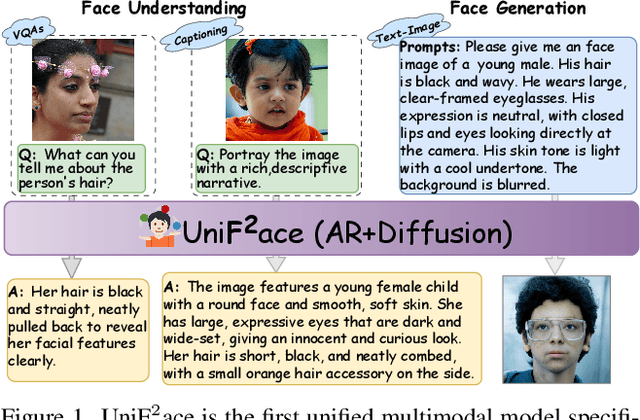


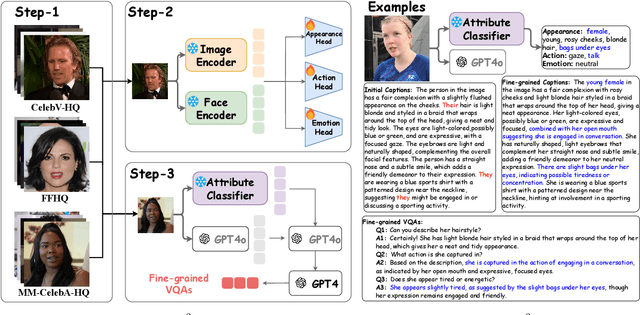
Abstract:Unified multimodal models (UMMs) have emerged as a powerful paradigm in foundational computer vision research, demonstrating significant potential in both image understanding and generation. However, existing research in the face domain primarily focuses on $\textbf{coarse}$ facial attribute understanding, with limited capacity to handle $\textbf{fine-grained}$ facial attributes and without addressing generation capabilities. To overcome these limitations, we propose Uni$\textbf{F}^2$ace, the first UMM tailored specifically for fine-grained face understanding and generation. In general, we train Uni$\textbf{F}^2$ace on a self-constructed, specialized dataset utilizing two mutually beneficial diffusion techniques and a two-level mixture-of-experts architecture. Specifically, we first build a large-scale facial dataset, Uni$\textbf{F}^2$ace-130K, which contains 130K image-text pairs with one million question-answering pairs that span a wide range of facial attributes. Second, we establish a theoretical connection between discrete diffusion score matching and masked generative models, optimizing both evidence lower bounds simultaneously, which significantly improves the model's ability to synthesize facial details. Finally, we introduce both token-level and sequence-level mixture-of-experts, enabling efficient fine-grained representation learning for both understanding and generation tasks. Extensive experiments on Uni$\textbf{F}^2$ace-130K demonstrate that Uni$\textbf{F}^2$ace outperforms existing UMMs and generative models, achieving superior performance across both understanding and generation tasks.
Efficient 3D Recognition with Event-driven Spike Sparse Convolution
Dec 10, 2024



Abstract:Spiking Neural Networks (SNNs) provide an energy-efficient way to extract 3D spatio-temporal features. Point clouds are sparse 3D spatial data, which suggests that SNNs should be well-suited for processing them. However, when applying SNNs to point clouds, they often exhibit limited performance and fewer application scenarios. We attribute this to inappropriate preprocessing and feature extraction methods. To address this issue, we first introduce the Spike Voxel Coding (SVC) scheme, which encodes the 3D point clouds into a sparse spike train space, reducing the storage requirements and saving time on point cloud preprocessing. Then, we propose a Spike Sparse Convolution (SSC) model for efficiently extracting 3D sparse point cloud features. Combining SVC and SSC, we design an efficient 3D SNN backbone (E-3DSNN), which is friendly with neuromorphic hardware. For instance, SSC can be implemented on neuromorphic chips with only minor modifications to the addressing function of vanilla spike convolution. Experiments on ModelNet40, KITTI, and Semantic KITTI datasets demonstrate that E-3DSNN achieves state-of-the-art (SOTA) results with remarkable efficiency. Notably, our E-3DSNN (1.87M) obtained 91.7\% top-1 accuracy on ModelNet40, surpassing the current best SNN baselines (14.3M) by 3.0\%. To our best knowledge, it is the first direct training 3D SNN backbone that can simultaneously handle various 3D computer vision tasks (e.g., classification, detection, and segmentation) with an event-driven nature. Code is available: https://github.com/bollossom/E-3DSNN/.
Scaling Spike-driven Transformer with Efficient Spike Firing Approximation Training
Nov 25, 2024Abstract:The ambition of brain-inspired Spiking Neural Networks (SNNs) is to become a low-power alternative to traditional Artificial Neural Networks (ANNs). This work addresses two major challenges in realizing this vision: the performance gap between SNNs and ANNs, and the high training costs of SNNs. We identify intrinsic flaws in spiking neurons caused by binary firing mechanisms and propose a Spike Firing Approximation (SFA) method using integer training and spike-driven inference. This optimizes the spike firing pattern of spiking neurons, enhancing efficient training, reducing power consumption, improving performance, enabling easier scaling, and better utilizing neuromorphic chips. We also develop an efficient spike-driven Transformer architecture and a spike-masked autoencoder to prevent performance degradation during SNN scaling. On ImageNet-1k, we achieve state-of-the-art top-1 accuracy of 78.5\%, 79.8\%, 84.0\%, and 86.2\% with models containing 10M, 19M, 83M, and 173M parameters, respectively. For instance, the 10M model outperforms the best existing SNN by 7.2\% on ImageNet, with training time acceleration and inference energy efficiency improved by 4.5$\times$ and 3.9$\times$, respectively. We validate the effectiveness and efficiency of the proposed method across various tasks, including object detection, semantic segmentation, and neuromorphic vision tasks. This work enables SNNs to match ANN performance while maintaining the low-power advantage, marking a significant step towards SNNs as a general visual backbone. Code is available at https://github.com/BICLab/Spike-Driven-Transformer-V3.
Scalable Autoregressive Image Generation with Mamba
Aug 22, 2024Abstract:We introduce AiM, an autoregressive (AR) image generative model based on Mamba architecture. AiM employs Mamba, a novel state-space model characterized by its exceptional performance for long-sequence modeling with linear time complexity, to supplant the commonly utilized Transformers in AR image generation models, aiming to achieve both superior generation quality and enhanced inference speed. Unlike existing methods that adapt Mamba to handle two-dimensional signals via multi-directional scan, AiM directly utilizes the next-token prediction paradigm for autoregressive image generation. This approach circumvents the need for extensive modifications to enable Mamba to learn 2D spatial representations. By implementing straightforward yet strategically targeted modifications for visual generative tasks, we preserve Mamba's core structure, fully exploiting its efficient long-sequence modeling capabilities and scalability. We provide AiM models in various scales, with parameter counts ranging from 148M to 1.3B. On the ImageNet1K 256*256 benchmark, our best AiM model achieves a FID of 2.21, surpassing all existing AR models of comparable parameter counts and demonstrating significant competitiveness against diffusion models, with 2 to 10 times faster inference speed. Code is available at https://github.com/hp-l33/AiM
RSC-SNN: Exploring the Trade-off Between Adversarial Robustness and Accuracy in Spiking Neural Networks via Randomized Smoothing Coding
Jul 29, 2024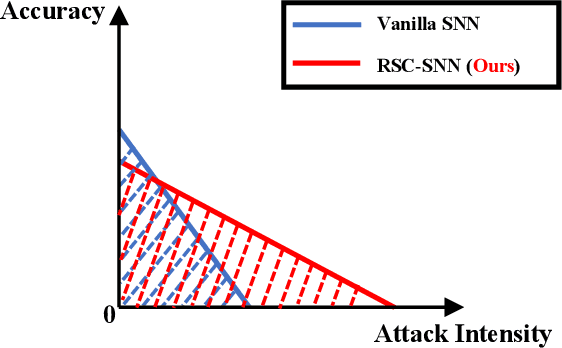



Abstract:Spiking Neural Networks (SNNs) have received widespread attention due to their unique neuronal dynamics and low-power nature. Previous research empirically shows that SNNs with Poisson coding are more robust than Artificial Neural Networks (ANNs) on small-scale datasets. However, it is still unclear in theory how the adversarial robustness of SNNs is derived, and whether SNNs can still maintain its adversarial robustness advantage on large-scale dataset tasks. This work theoretically demonstrates that SNN's inherent adversarial robustness stems from its Poisson coding. We reveal the conceptual equivalence of Poisson coding and randomized smoothing in defense strategies, and analyze in depth the trade-off between accuracy and adversarial robustness in SNNs via the proposed Randomized Smoothing Coding (RSC) method. Experiments demonstrate that the proposed RSC-SNNs show remarkable adversarial robustness, surpassing ANNs and achieving state-of-the-art robustness results on large-scale dataset ImageNet. Our open-source implementation code is available at this https URL: https://github.com/KemingWu/RSC-SNN.
When Spiking neural networks meet temporal attention image decoding and adaptive spiking neuron
Jun 05, 2024

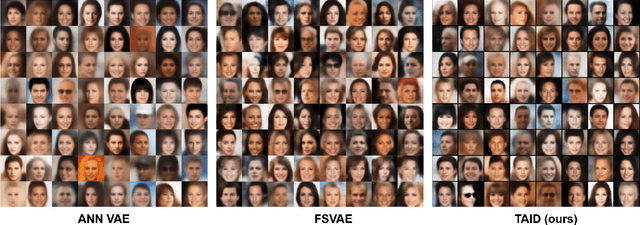

Abstract:Spiking Neural Networks (SNNs) are capable of encoding and processing temporal information in a biologically plausible way. However, most existing SNN-based methods for image tasks do not fully exploit this feature. Moreover, they often overlook the role of adaptive threshold in spiking neurons, which can enhance their dynamic behavior and learning ability. To address these issues, we propose a novel method for image decoding based on temporal attention (TAID) and an adaptive Leaky-Integrate-and-Fire (ALIF) neuron model. Our method leverages the temporal information of SNN outputs to generate high-quality images that surpass the state-of-the-art (SOTA) in terms of Inception score, Fr\'echet Inception Distance, and Fr\'echet Autoencoder Distance. Furthermore, our ALIF neuron model achieves remarkable classification accuracy on MNIST (99.78\%) and CIFAR-10 (93.89\%) datasets, demonstrating the effectiveness of learning adaptive thresholds for spiking neurons. The code is available at https://github.com/bollossom/ICLR_TINY_SNN.
 Add to Chrome
Add to Chrome Add to Firefox
Add to Firefox Add to Edge
Add to Edge